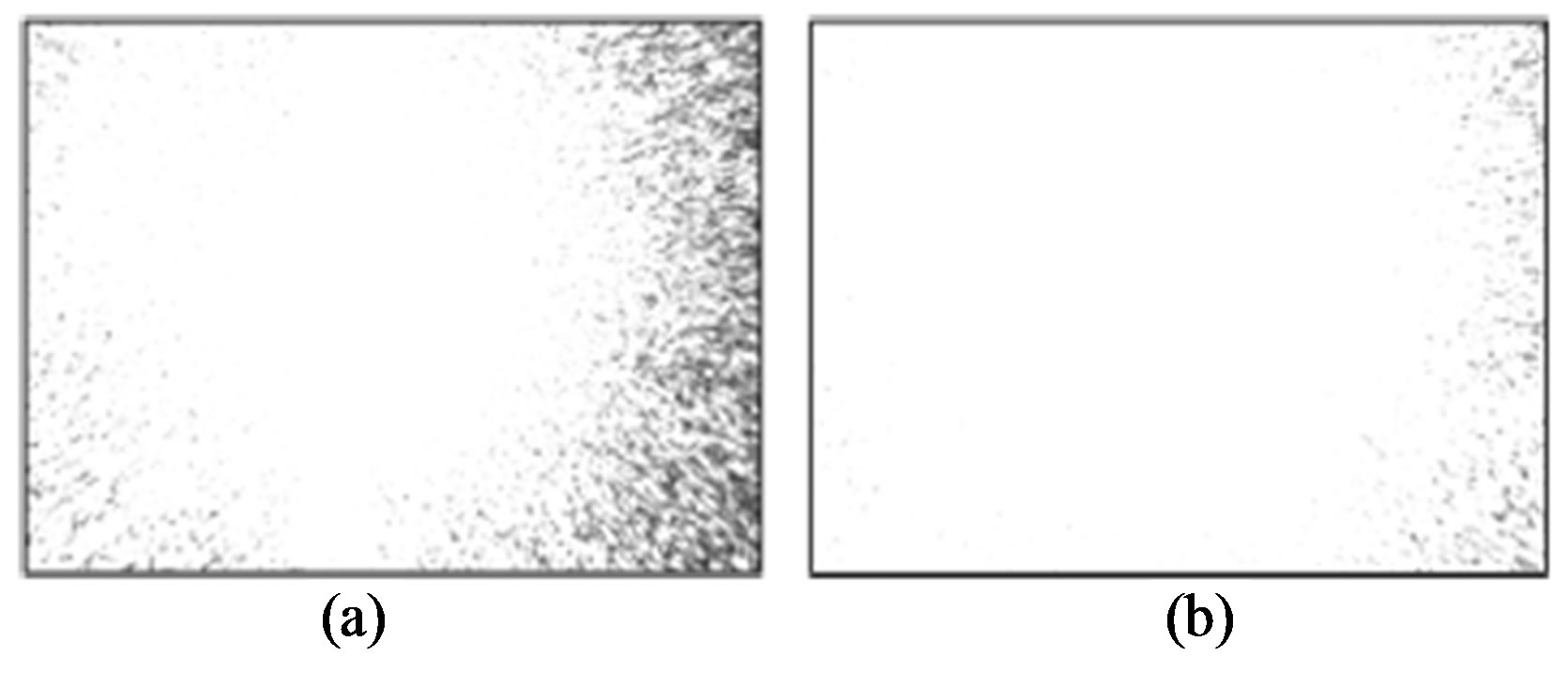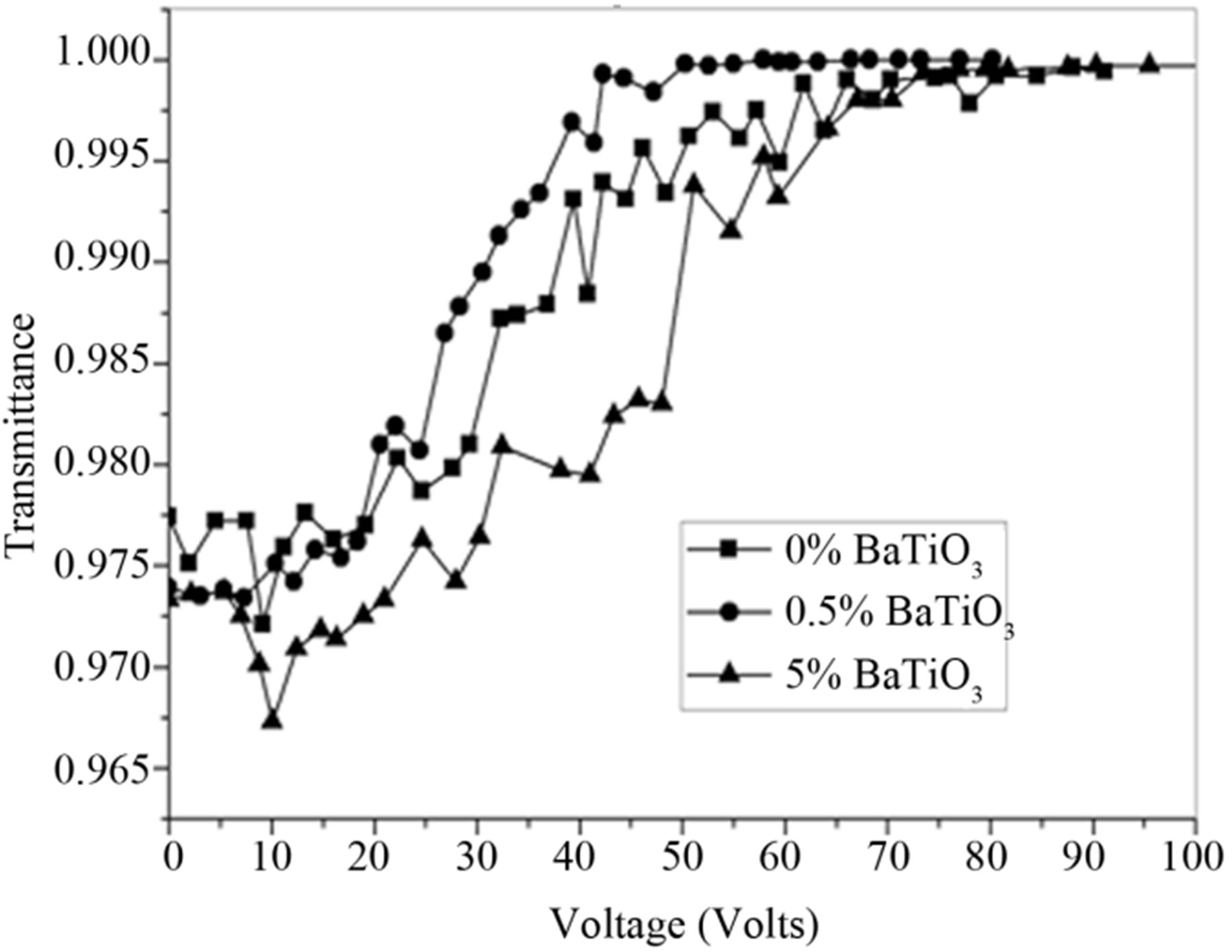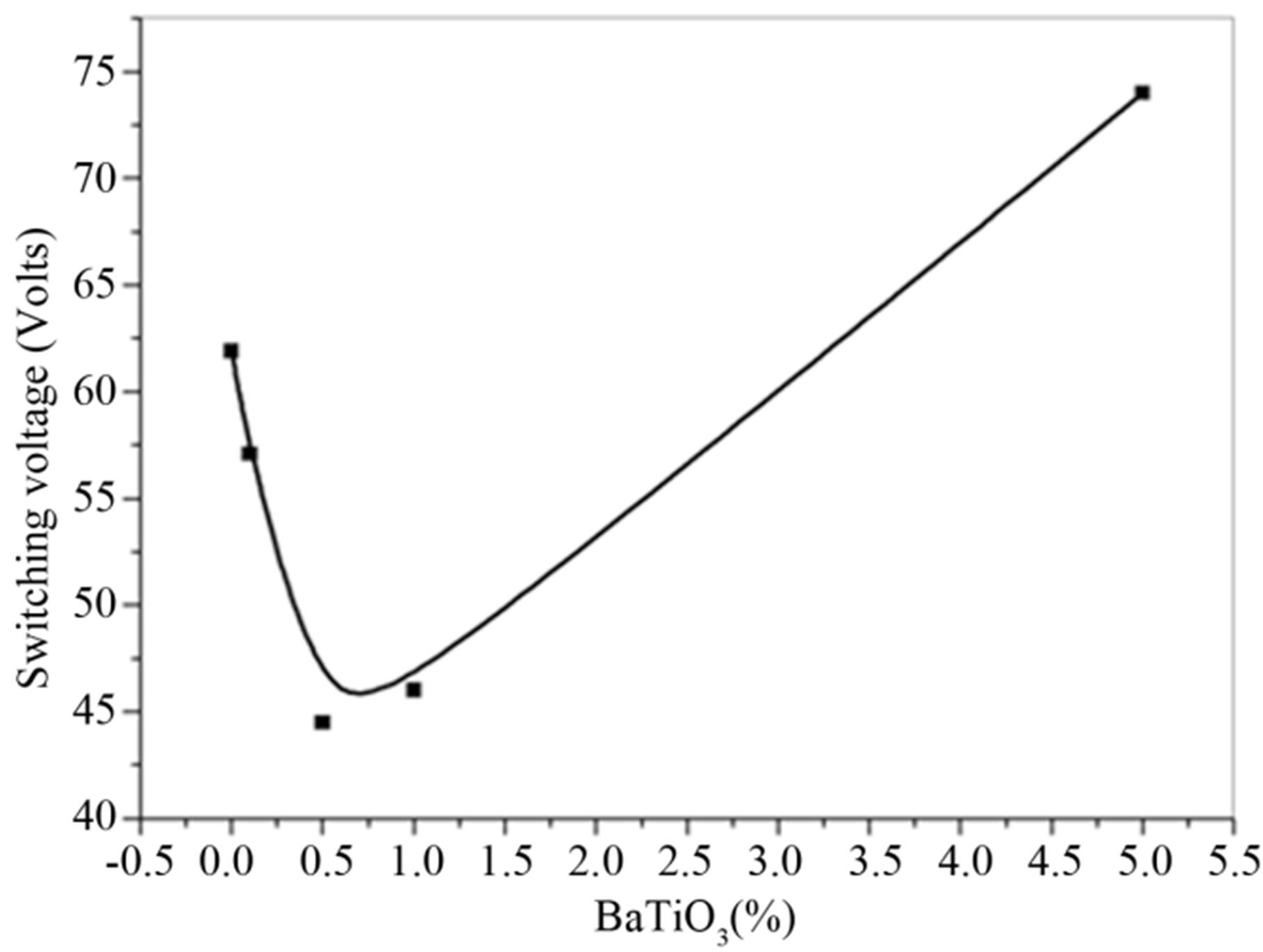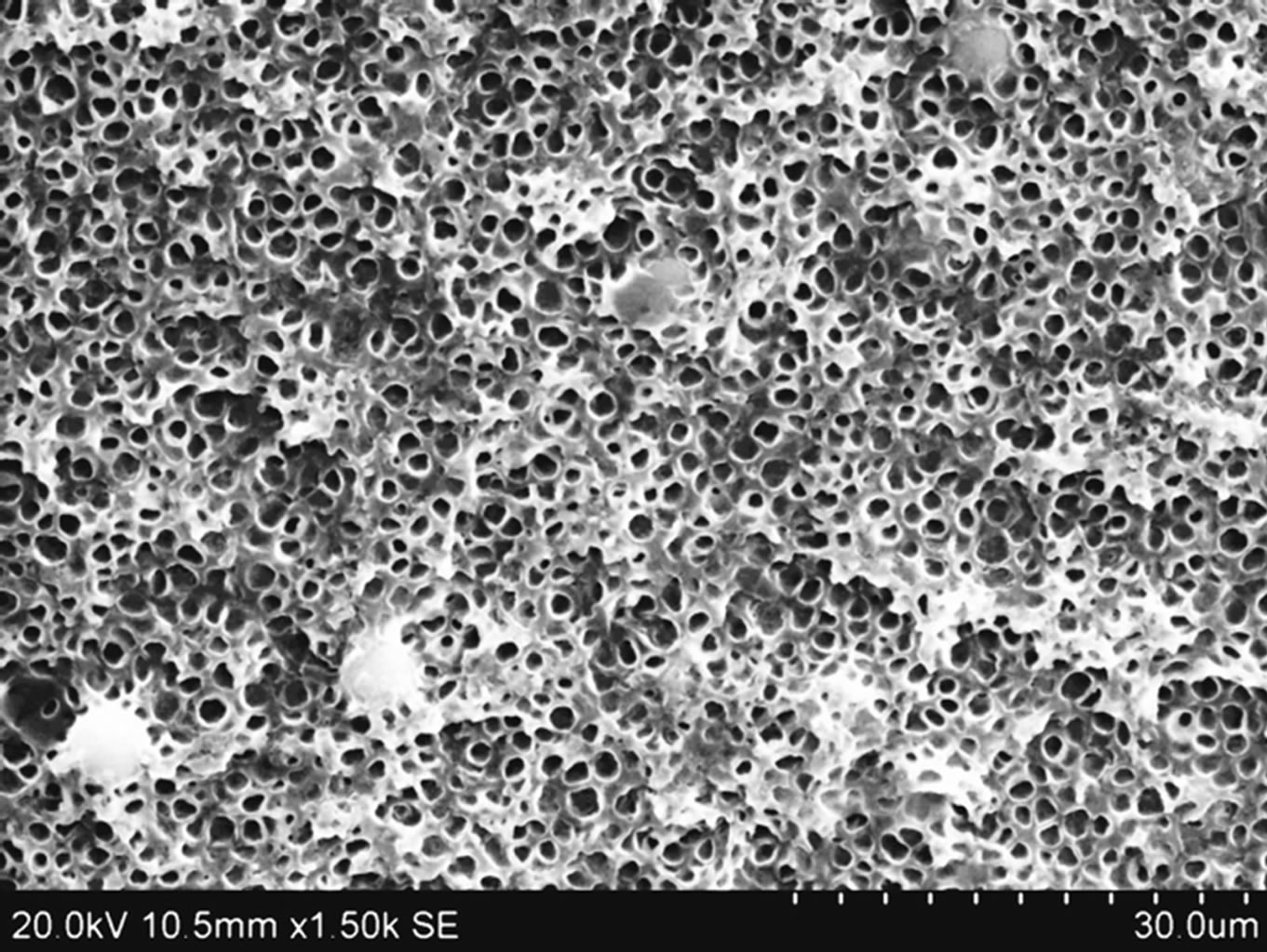Journal of Crystallization Process and Technology
Vol.4 No.1(2014), Article ID:42469,4 pages DOI:10.4236/jcpt.2014.41008
Effect of BaTiO3 Nanoparticle on Electro-Optical Properties of Polymer Dispersed Liquid Crystal Displays
![]()
1Department of GEBH, Sree Vidyanikethan Engineering College, A Rangampet, Tirupati, Andhra Pradesh, India; 2Department of Mechanical Engineering, National Institute of Technology Karnataka (NITK), Surathkal, Karnataka, India; 3School of Nano Science and Technology, National Institute of Technology Calicut (NITC), Kerala, India.
Email: soneyva@nitc.ac.in
Copyright © 2014 Mallikharjuna Rao Darla et al. This is an open access article distributed under the Creative Commons Attribution License, which permits unrestricted use, distribution, and reproduction in any medium, provided the original work is properly cited. In accordance of the Creative Commons Attribution License all Copyrights © 2014 are reserved for SCIRP and the owner of the intellectual property Mallikharjuna Rao Darla et al. All Copyright © 2014 are guarded by law and by SCIRP as a guardian.
Received July 14th, 2013; revised August 14th, 2013; accepted August 21st, 2013
Keywords:Polymer Dispersed Liquid Crystal; Barium Titanate; Liquid Crystal
ABSTRACT
Ferro nematic suspensions are the prominent materials to enhance the electro optical performance of liquid crystal displays. Electro optical properties of polymer dispersed liquid crystal (PDLC) display with the introduction of Barium Titanate nanoparticles have been investigated in this article and it is shown that there is a considerable enhancement in electro-optical response of the displays. The nanoparticles lower the switch-on electric field and thereby increase the optical transmission at certain voltages of the displays. The electro-optical characteristics of the PDLC cells were investigated with a He-Ne laser followed by MatLab calculations.
1. Introduction
Considerable attention has been paid to the fabrication of devices with polymer-liquid crystal composites. Polymer dispersed liquid crystals consists of submicron size droplets of liquid crystal (LC) embedded within a polymer matrix [1-4]. In the absence of external fields LC molecules in PDLC device are oriented randomly, thereby the scattering of light dominates, and it appears opaque. Application of sufficiently strong electric fields leads LC molecules to align so that the transmission through the PDLC increases. The electro-optical effect is the basis for many PDLC based applications, owing to their easy processing and flexibility, due to which polymer-LC composites have been studied for a wide variety of applications. Some of their possible applications include smart windows, optical shutters, diffractive optics, photorefractive systems, micro-displays, potential nuclear radiation detectors, and flexible displays etc. [5-9]. External perturbations affect the alignment of LC molecules, which can influence the electro-optical properties of the displays. Incorporation of noble metal nanoparticle (NP) in PDLC microstructure is particularly important because of the possibility of surface plasmon excitations [10-13] at the NP-polymer interface and their influence on the electro-optical properties of PDLCs. A few notable developments on this particular area have been reported by recent researchers. Research results includes, Zhu et al. [14] have observed faster response in Ag NPs doped PDLCs, Yaroshchuk et al. [15,16] have used inorganic NPs and observed improved angular characteristics of light transmission through PDLCs. Alfonso Hinojosa et al. reposted effects of gold nanoparticles on electro-optical properties of PDLC cells [10]. Here, we present evidence for rather large changes in the electrooptical properties of PDLCs containing relatively small concentrations of BaTiO3 NPs.
2. Materials and Methodology
PDLC cells were fabricated with a liquid crystal (E7) purchased from Merck and used as received, acrylic monomer mixture (Photolec A-202 optical adhesive) from Nissan chemicals, and a spherical divinylbenzene (DVB) spacer with 5 micron in size from Nissan chamicals. Nano BaTiO3 with approximately 50 nm diameter was purchased from Sigma-Aldrich and used as ferro-electric nanomaterial.
3. Experimental
LC composites were prepared by the addition of specific amounts of BaTiO3 to the E7 mixture followed by ultra sonication with a probe for 15 minutes. Optical adhesive was added to the LC mixture with thorough mixing under mechanical stirring for 10 minutes. The ITO glass plates were properly cleaned, glued and cured under UV exposure for 25 minutes [17,18]. Morphology of the cells was studied with high resolution field-emission scanning electron microscope (SU-6600) at 20 kV accelerating voltage. The electro-optical properties were measured with He-Ne continuous laser. The block diagram of the experimental setup is shown in Figure 1. Transmitted beam of laser through the cell was captured by hi-speed CCD camera at different applied voltages. Typical black and white pictures of transmitted beam of laser through PDLC cells at 60 volts are depicted in Figure 2.
From the captured hi-resolution black and white pictures, transmittance was calculated using MatLab simulations. Relative transmittances of displays were plotted against corresponding voltages from the obtained values as shown in Figure 3. The percentage enhancement of switch on voltage was calculated. The switch on voltage of the displays and percentage of BaTiO3 added were plotted in Figure 4.
4. Results and Discussion
The relative concentration of Barium titanate to the liquid crystal has been varied from 0.2 to 5 weight percentage. The electro-optical properties were performed using He-Ne continuous LASER at room temperature and found the synergetic enhancement in switching voltages in PDLC cells upon introducing the barium titanate nanoparticles. It has been found that switchover voltage for displays without BaTiO3 was 62 volts and with 0.5% BaTiO3 was 45 volts. It is observed that the threshold voltages of displays were lowered by almost 27 percent. As mentioned in the referred literature the electro-optical properties of liquid crystals are sensitive to their micro structure [10,19]. It is therefore reasonable to assume that

Figure 1. Block diagram of the experimental setup for electro-optical characterization of PDLC cells.

Figure 2. Hi-resolution black and white pictures of transmitted light of laser beam through PDLC cell (a) without BaTiO3 and (b) with 0.5% BaTiO3 nanomaterial at 60 volts applied voltage.

Figure 3. Relative transmittance verses corresponding voltages of PDLC cells.

Figure 4. Switching voltage of the cells and percentage of BaTiO3 were added.
enhancement of electro-optical properties of liquid crystal cells were due to the build up of local electric fields by the addition of ferroelectric nanoparticles like BaTiO3. These low energy liquid crystal displays are essential for present and future applications. The morphology of PDLC cells with 30 weight percentage of polymer were presented in Figure 5. From the Figure 5, voids are the

Figure 5. SEM picture of 30 wt% LC to the polymer dispersed liquid crystal; voids are the finger prints of liquid crystal droplets.
finger prints of the LC material and well developed sponge like structure of polymer having voids of about 3 - 5 µm indicates the optimum composition (30 - 40 volume fraction of the polymer) of the cells.
5. Conclusion
In summary, with the introduction of relatively small concentrations of Barium titanate produces synergetic changes in the electro-optical properties of PDLC displays. With the electro-optical data it is further believed that the surface plasmon excitations at metal/dielectric interfaces in the composite material may contribute to the build up of local electric fields in PDLC cells containing BaTiO3 nanomaterial.
Acknowledgements
We acknowledge Dr. Sajith V. and Mr. Riyasudeen N., NIT Calicut, India, for their useful help.
REFERENCES
- S. Chandrasekhar, “Liquid Crystals,” Cambridge University Press, Cambridge, 1997.
- S. Kumar, “Liquid Crystals: Experimental Study of Physical Properties and Phase Transitions,” Cambridge University Press, Cambridge, 2001.
- J. W. Doane, A. Golemme, J. L. West Jr., J. B. Whitehead and B. G. Wu, “Polymer Dispersed Liquid Crystals for Display Application,” Molecular Crystals and Liquid Crystals, Vol. 165, No. 1, 1988, pp. 511-532.
- S. C. Sharma, “A Review of the Electro-Optical Properties and Their Modification by Radiation in PolymerDispersed Liquid Crystals and Thin Films Containing CdSe/ZnS Quantum Dots,” Material Science and Engineering B, Vol. 168, No. 1-3, 2010, pp. 5-15. http://dx.doi.org/10.1016/j.mseb.2010.01.014
- L. Bouteiller and P. L. Barny, “Polymer Dispersed Liquid Crystals: Preparation, Operation and Application,” Liquid crystals, Vol. 21, No. 2, 1996, pp. 157-174. http://dx.doi.org/10.1080/02678299608032820
- G. Spruce and R. D. Pringle, “Polymer Dispersed Liquid Crystal (PDLC) Films,” Electronic Communication Engineering Journal, Vol. 4, No. 2, 1992, pp. 91-100. http://dx.doi.org/10.1049/ecej:19920017
- G. P. Crawford and S. Zumer, “Liquid Crystals in Complex Geometries,” Taylor & Francis, London, 1996.
- D. Armitage, I. Underwood and S. T. Wu, “Introduction to Microdisplays,” Chichester, Wiley, 2006. http://dx.doi.org/10.1002/9780470057056
- G. P. Crawford, “Flexible Flat Panel Displays,” Chichester, Wiley, 2005. http://dx.doi.org/10.1002/0470870508
- A. Hinojosa and S. C. Sharma, “Effects of Gold Nanoparticles on Electro-Optical Properties of a Polymer-Dispersed Liquid Crystal,” Applied Physics Letters, Vol. 97, No. 8, 2010, Article ID: 081114. http://dx.doi.org/10.1063/1.3482942
- S. I. Bozhevolnyi and V. M. Shalaev, “Nanophotonics with Surface Plasmons-Part I,” Photonics Spectra, Vol. 40, No. 1, 2006, pp. 58-66.
- V. M. Shalaev and S. I. Bozhevolnyi, “Nanophotonics with Surface Plasmons-Part II,” Photonics Spectra, Vol. 40, No. 2, 2006, pp. 66-72.
- W. L. Barnes, A. Dereux and T. V. Ebbesen, “Surface Plasmon Sub-Wavelength Optics,” Nature, Vol. 424, No. 6950, 2003, pp. 824-830. http://dx.doi.org/10.1038/nature01937
- T. Zhu, B. Tan, X. Pan, W. Tao and J Xu, “Electro-OpTical Characteristic of Frequency Modulation in Nano Ag Doped PDLC,” IEEE Proceedings of the Symposium on Photonics and Optoelectronics, Wuhan, 14-16 August 2009, pp. 1-4. http://dx.doi.org/10.1109/SOPO.2009.5230055
- V. Yaroshchuk and L. O. Dolgov, “Electro-Optics and Structure of Polymer Dispersed Liquid Crystals Doped with Nanoparticles of Inorganic Materials,” Optical Materials, Vol. 29, No. 8, 2007, pp. 1097-1102. http://dx.doi.org/10.1016/j.optmat.2006.04.009
- V. Yaroshchuk, L. O. Dolgov and A. D. Kiselev, “Electro-Optics and Structural Peculiarities of Liquid CrystalNanoparticle-Polymer Composite,” Physical Review E, Vol. 72, No. 5, 2005, Article ID: 051715. http://dx.doi.org/10.1103/PhysRevE.72.051715
- R. M. Henry, R. A. Ramsey and S. C. Sharma, “Effects of Cross Linking Agent, Cure Temperature, and UV Flux on the Electro-Optical Properties of Polymer-Dispersed Liquid Crystal Cells,” Journal of Polymer Science, Part B: Polymer Physics, Vol. 42, No. 3, 2004, pp. 404-410. http://dx.doi.org/10.1002/polb.10665
- R. M. Henry, S. C. Sharma, R. A. Ramsey, M. L. Cramer and J. B. Atman, “Effects of Formulation Variables on Liquid Crystal Droplet Size Distributions in Ultraviolet-Cured Polymer-Dispersed Liquid Crystal Cells,” Journal of Polymer Science, Part B: Polymer Physics, Vol. 43, No. 14, 2005, pp. 1842-1848. http://dx.doi.org/10.1002/polb.20438
- H. K. Bisoyi and S. Kumar, “Carbon Nanotubes in Discotic Liquid Crystals,” Journal of Indian Institute of Science, Vol. 89, No. 2, 2009, pp. 101-112.

